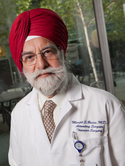High dose-rate intraluminal brachytherapy for carcinoma of the esophagus Journal Article
| Authors: | Moni, J.; Armstrong, J. G.; Minsky, B. D.; Bains, M. S.; Harrison, L. B. |
| Article Title: | High dose-rate intraluminal brachytherapy for carcinoma of the esophagus |
| Abstract: | Objectives: To determine the effectiveness and toxicity of high dose-rate intraluminal brachytherapy as a component of treatment on local control and palliation in patients with esophageal cancer. Materials and methods: From 1980 to 1991, 47 evaluable patients received high dose-rate intraluminal brachytherapy as a component of treatment for esophageal cancer. They were divided into three treatment groups: Group A-21 patients treated for primary, non-metastatic disease; Group B-14 patients with recurrent, non-metastatic disease, and Group C-12 patients with metastatic disease. Results: Twelve of 21 (57%) Group A patients had a complete response at the end of treatment and eight (38%) remained locally controlled at last follow-up. The median survival was 11 months and two-year actuarial survival was 27%. For Group B, local control rates were 64% at completion of treatment and 36% at last follow-up. Median survival was six months. Only 2/12 (17%) of Group C patients were locally controlled and median survival was 5.5 months. For the total patient group, severe (Grades 3-4) complications were seen in 17/47 (36%) patients. Fistulae occurred in 8/47 (17%) patients: 4.5 (80%) patients receiving multiple courses of brachytherapy compared to 4/42 (9.5%) patients treated with a single course. P = 0.002. Conclusions: Our data suggest that the use of high dose-rate intraluminal brachytherapy as a component of treatment in esophageal cancer is a reasonable approach. The results of ongoing clinical trials will help determine the role of high dose-rate intraluminal brachytherapy in the multimodal management of esophageal cancer. |
| Keywords: | adult; cancer survival; clinical article; controlled study; aged; clinical trial; radiation dose; cancer palliative therapy; metastasis; controlled clinical trial; brachytherapy; esophagus carcinoma; esophagus fistula; human; male; female; priority journal; article |
| Journal Title: | Diseases of the Esophagus |
| Volume: | 9 |
| Issue: | 2 |
| ISSN: | 1120-8694 |
| Publisher: | Oxford University Press |
| Date Published: | 1996-04-01 |
| Start Page: | 123 |
| End Page: | 127 |
| Language: | English |
| PROVIDER: | scopus |
| DOI: | 10.1093/dote/9.2.123 |
| DOI/URL: | |
| Notes: | Article -- Export Date: 22 November 2017 -- Source: Scopus |
Altmetric
Citation Impact
BMJ Impact Analytics
Related MSK Work






